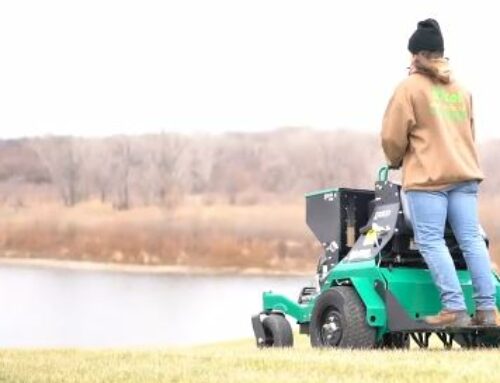5 Best Practices for Lawn Care in Des Moines
If you’re a homeowner in Des Moines, understanding the best practices for lawn care is vital. This knowledge ensures that your grass remains lush and vibrant throughout the year. However, with so many options available on the market today it can be hard to know what’s best for your yard. That’s why we’ve curated these five straightforward tips, embodying the best practices for lawn care, to ensure your lawn receives optimal attention and love.
1. The best time to fertilize a lawn is in early autumn.
This is because fall is the ideal time for grass to absorb nutrients and grow well, which will give you a thick, healthy lawn by spring. In addition to fertilizing your lawn in the fall, you should also aerate it. Aeration helps improve drainage and allows air into the soil so that roots have more access to oxygen. It also helps break up compacted soil and encourages water infiltration into the ground instead of allowing it all to run off when it rains.
Core aeration should be done after your grass has been mowed down with clippings still present on top so they can decompose quickly while soaking up minerals from both worm castings and fertilizer applications that follow aeration work pursuits. You should overseed any bare patches left behind after mowing any early autumn growth.
2. Core aeration is an important practice.
Core aeration is a process of removing plugs of soil from your lawn. It helps improve soil health and drainage, which ultimately leads to a healthier lawn. The best time to core aerate your lawn is in late spring or early autumn. This gives the grass time to recover before winter sets in, allowing it to store nutrients for next year’s growth cycle. A professional will be able to determine how many times you need core aeration done based on factors such as how much traffic your yard gets and its overall condition.
3. Avoid overwatering your lawn.
Don’t overwater your lawn. Overwatering can cause disease and fungal problems, which will make it look less green and healthy. If you’re new to lawn care or have never had to worry about watering before, this is one of the most important things to remember. The best time to water your grass if you want to avoid overdoing it (and ruining your plants!) is in the early morning or evening hours. This way, any excess water will be absorbed by the ground before midday when temperatures are warmest—the plant won’t be able to take as much moisture then because it’s already been through its heat cycle for the day!
4. Mow the right way.
The most important step in mowing your lawn is to do it at the correct height. You want to cut off about one-third of the grass blade, which will stimulate new growth while not sacrificing too much of its nutrient-rich crown. Cutting it any shorter than this will cause stress, and cutting it any longer can encourage fungus and disease to grow. If you have areas where water collects after rainfall or irrigation, those spots should be trimmed first so they don’t clog up with excess debris before getting back around to mow the rest of your lawn.
You also should consider factors like temperature and humidity when deciding how often (or infrequently) you want to cut your grass: if our temps get above 90°F for extended periods of time or we see prolonged periods of higher humidity levels (such as during summer thunderstorms), then we’ll usually recommend weekly maintenance rather than biweekly or monthly care since that’s typically what works best for Lawn Care in Indianola IA.
5. Mulch around plants and bushes.
Mulching is one of the best things you can do for your lawn. It helps control weeds and retains moisture in the soil, preventing water from evaporating through the ground. Mulch also keeps soil temperature even so that no part of your lawn gets too hot or too cold, which can damage plants and weaken them over time. It’s also a good way to keep erosion under control by preventing dirt from washing away with heavy rains.
Mulch comes in many different forms—from wood chips to straw to shredded leaves—but they all serve a similar purpose: they prevent bare soil from being exposed to harsh conditions like wind and rain while still letting air circulate freely around plant roots so they stay healthy!
Conclusion: Implementing the Best Practices for Lawn Care
Lawn care in Des Moines, especially when adhering to these best practices for lawn care, is pivotal for the health of both your turf and home. It might seem overwhelming, but an abundance of resources and this guide aim to simplify the process, giving you a clear starting point for your lawn’s upkeep.
Share This Story, Choose Your Platform!
Recent Posts
Is Winter the Best Time for Pruning?
Winter pruning is indeed the best time for Tree pruning, if pruning is [...]
Ultimate Guide to Lawn Aeration and Overseeding Mastery
A healthy, lush lawn doesn’t just happen—it takes care and the right approach. [...]
The Superpower of Lawn Aeration: Unlocking the secret to a vibrant Lawn
When you envision a stunning, vibrant lawn, what springs to mind? Probably a lawn [...]
Yellow Nutsedge “The Lime Green Grass invader”
It is that time of year, Yellow Nutsedge is starting to show up within our [...]
The Art of Pruning Hydrangea’s
Pruning Hydrangea's If you're growing hydrangeas at your West Des Moines home, let's keep [...]
Achieving that Perfect Urbandale Lawn in 5 Steps
Maintaining a perfect Urbandale lawn is about more than just regular watering and fertilization. [...]










